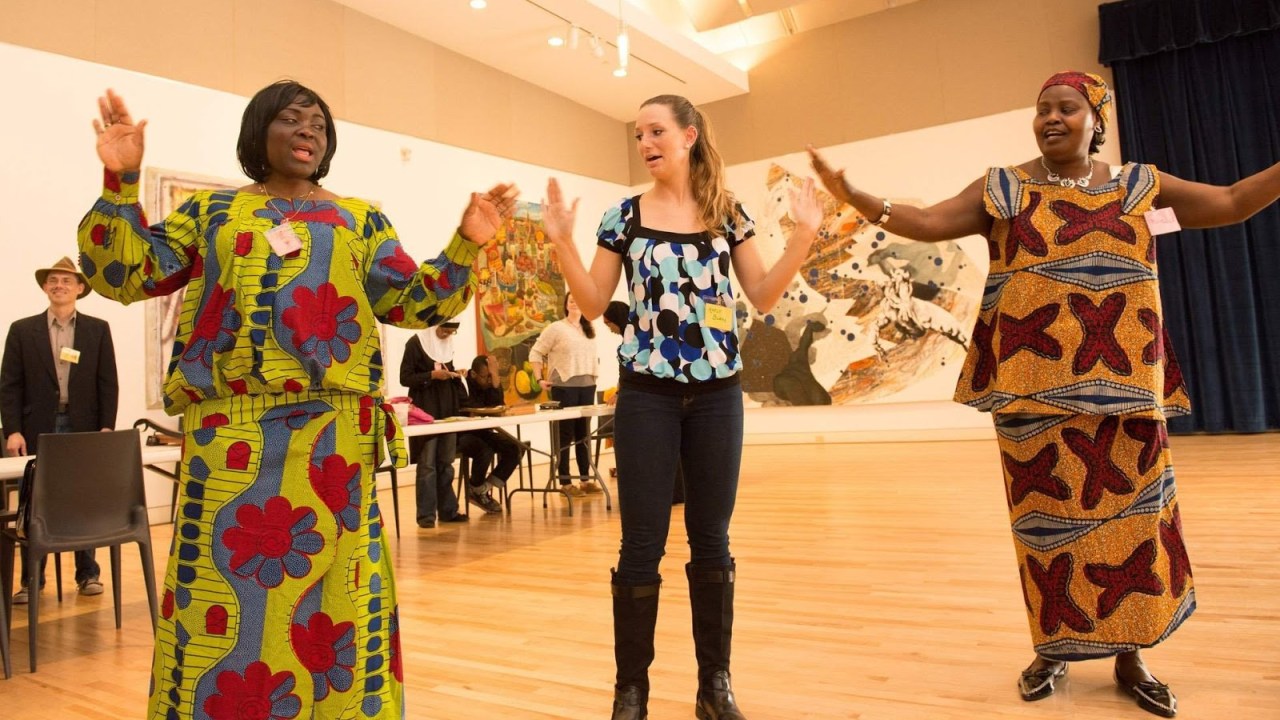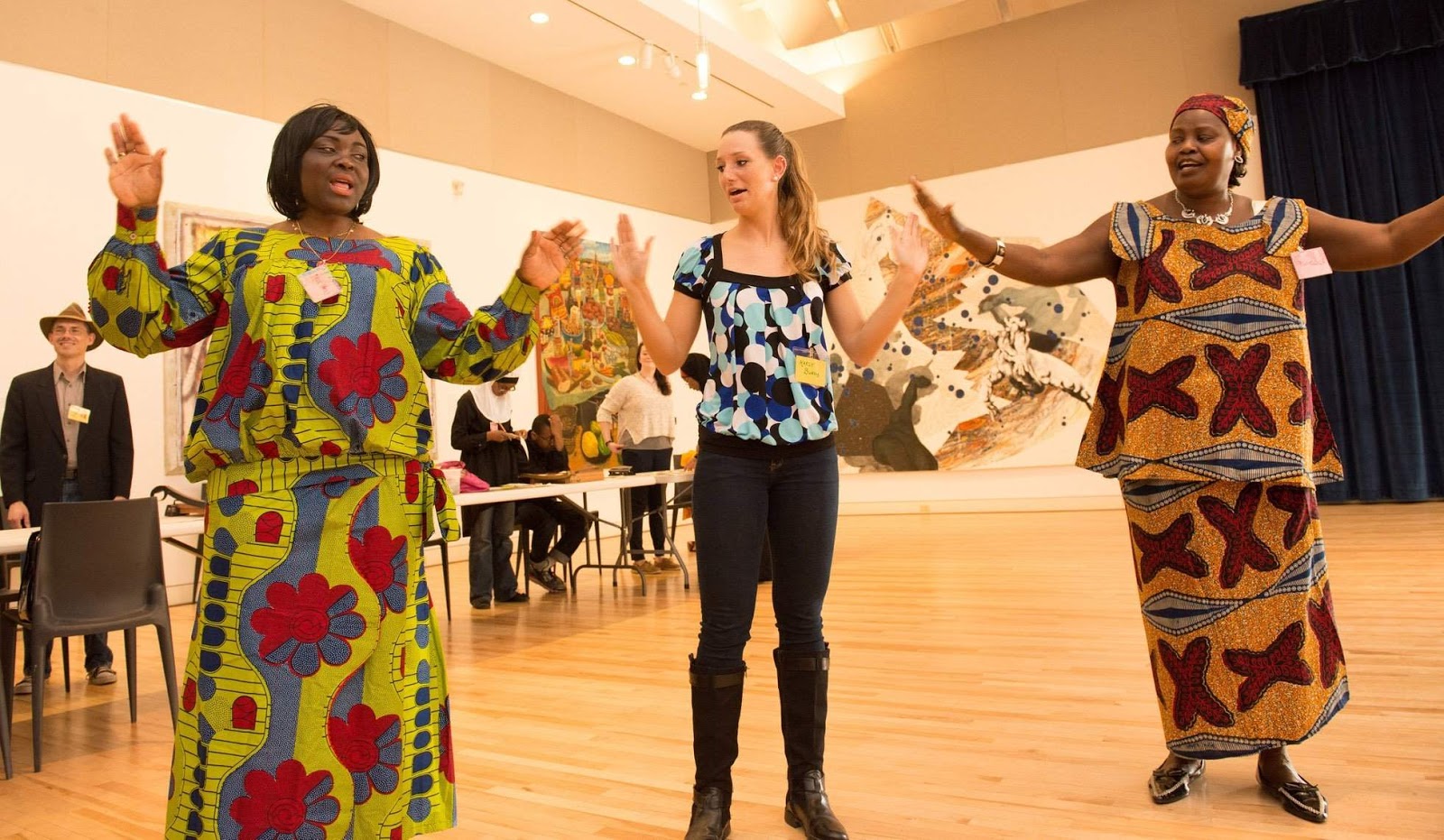
As I noted in last month’s post about the web site Museums & Migration, mass migration has been described as “the defining issue of this century.” A large segment of these migrants are refugees, fleeing political upheaval, persecution or environmental disasters. The federal Office of Refugee Resettlement has helped over 10,000 refugees settle in Erie, Pennsylvania. In this week’s post John Vanco, Director of the Erie Art Museum, tells us how the museum is helping people these new residents, who now make up over ten per cent of the city’s population.
The Erie Art Museum is a medium-sized institution in a rust-belt city. We are fortunate enough to have a broad mission that includes encouraging art in all its forms and building community among artists, art students and the public. Even so, some board members and staff have questioned why an art museum has embraced an early childhood and refugee-based program that has nothing to do with current exhibits. We do it because no other institution in our region is treating refugees as the cultural assets that they are. We do it because we’ve literally seen the lives of refugees change when they get jobs that honor their talents. And, we have watched them develop as artists as a result.
 “Old Songs New Opportunities” is not a typical art museum program, but it is typical of the new way museums are reaching communities and creating life-changing programming. Among the functions of the Erie Art Museum, the regional Folk Art Support Center is very important. We work with regional folk artists and help them preserve and share their traditions. The refugee community in Erie is especially rich in folk traditions and particularly interested in seeing their work preserved—whatever forced them to flee their native lands has put their folk art in jeopardy. They come here having lost everything—their homes and possessions, their citizenship in their native countries, and often the lives of friends and family members. Under pressure to assimilate, learn English, and make a living—relentlessly reinforced by the rapid Americanization of their offspring—their cultural traditions are often abandoned, despite their power to make meaning of the tumult in their lives. Our museum believes that helping them figure out how to transplant, preserve, and continue those traditions is crucial work.
“Old Songs New Opportunities” is not a typical art museum program, but it is typical of the new way museums are reaching communities and creating life-changing programming. Among the functions of the Erie Art Museum, the regional Folk Art Support Center is very important. We work with regional folk artists and help them preserve and share their traditions. The refugee community in Erie is especially rich in folk traditions and particularly interested in seeing their work preserved—whatever forced them to flee their native lands has put their folk art in jeopardy. They come here having lost everything—their homes and possessions, their citizenship in their native countries, and often the lives of friends and family members. Under pressure to assimilate, learn English, and make a living—relentlessly reinforced by the rapid Americanization of their offspring—their cultural traditions are often abandoned, despite their power to make meaning of the tumult in their lives. Our museum believes that helping them figure out how to transplant, preserve, and continue those traditions is crucial work. We also recognize that folk art flourishes when it serves a need beyond aesthetic contemplation. “Old Songs New Opportunities” (OSNO) literally puts refugee women and their substantial indigenous knowledge to work. Refugee women are culturally rich, but economically poor. They need training and employment opportunities. Since 2003 we’ve been training former refugee and Hispanic women to work in childcare and to share their cultural knowledge and traditional children’s songs on the job. Their rich folk culture can be an anchor for these women as they grapple with the challenges of a new life in a new country. It can also be a treasure for our community. While most Americans have lost the ability to sing with and to our children, those from traditional cultures use song to bond with and educate their young.
Singing in American culture is considered the purview of professionals. Shows like “American Idol” symbolize and popularize the conception that singing is only for those with natural talent. Most Americans think of singing only in the context of a performance—our material wealth and high production standards bring an unending stream of perfectly polished recordings and videos into all our homes, iPods, and automobiles. Most childcare teachers were raised not with singing parents or caregivers, but with records, television, and compact discs.
Ironically, our children are deprived as a result. For thousands of years traditional cultures have used song and dance with children to soothe them, teach social skills, build fine and gross motor coordination, and spur language development. Research has proven that singing with children is essential to their brain development. Yet there are few American childcare teachers who are comfortable with singing and make use of its potential throughout the day. In 2013 we expanded “Old Songs New Opportunities” to provide song coaching for hundreds of local teachers. Former refugees enter our program and we place them in classrooms so that they can help Americans learn about their culture and draw from these lessons, implementing tools for classroom management like how to use songs to help children line up, clean up, or even wait for lunch. These “Old Songs New Opportunities” ambassadors also mentor teachers and help them learn how to use songs to improve the mood of their classroom, allow children to express themselves physically, vent frustrations, teach sharing, and mark transitions from one activity to another.
We have benefited from this work as well. We can boast excellent relationships with our refugee community, the social service agencies that serve them, and scores of child care programs. These relationships have generated new collaborations and an increase in tours. Former refugees and early childhood teachers who never would have considered visiting the museum are now part of our regular audience.
I’ve always been proud of our museum’s art collection. Now, I can also be proud of our song collection. We’ve collected over 100 traditional children’s songs from Bosnia, Russia, Ukraine, Bhutan, Nepal, Iraq, Palestine, Sudan, Congo, Burundi, Puerto Rico and Somalia. Today thousands of children across our county are singing these songs. We have produced recordings of all the songs, and have just released a compilation CD featuring 36 traditional children’s songs from around the world, selected from more than 100 collected to date.
As far as we know, “Old Songs New Opportunities” is the only program like it in the country. We are eager to find other communities that would like to pilot it. Although it may be a stretch for an art museum, this is a natural project for a children’s or historical museum. We believe that our program is an antidote to bigotry. It celebrates multiple perspectives and our universal desire to nurture young children.









As a community member of Erie, whose Art Museum has committed itself to this project, I am extremely proud and grateful.
When the Erie community asks, (as it does quite frequently in the form of commissioning outside studies) "How can we use the Arts to spur economic growth?" the Erie Art Museum didn't twiddle it's thumbs waiting for another organization with a "better fit" to do the work. Instead, the Museum staff leveraged their talents and relationships to create a truly innovative educational and economic model.
To boot, there are a slew of strategic byproducts as the article mentions: new partners, more tours, reaching a wider audience and growing strong relationships with local educators.
Instead of asking, "should the Museum take this on?" the Erie community should take the success of the Erie Art Museum's approach as a challenge: If an Art Museum can leverage community resources to this level, despite not having the ideal resources, imagine what my organization could do.